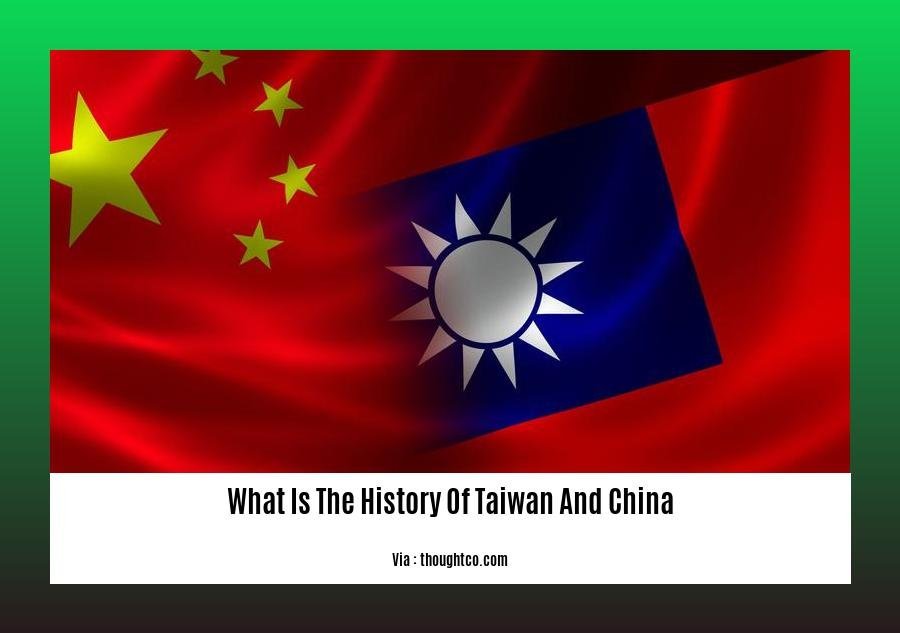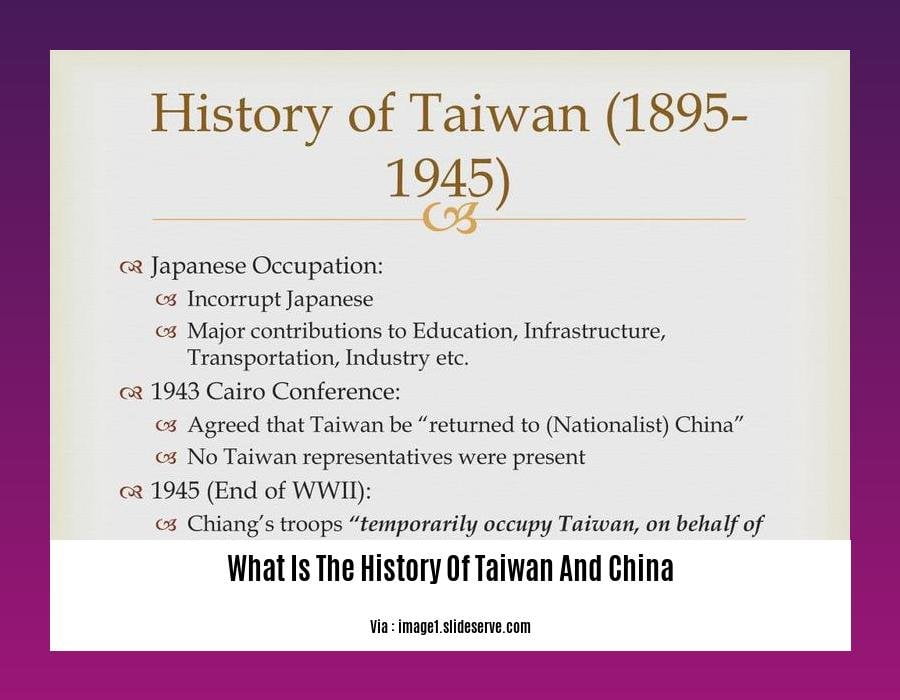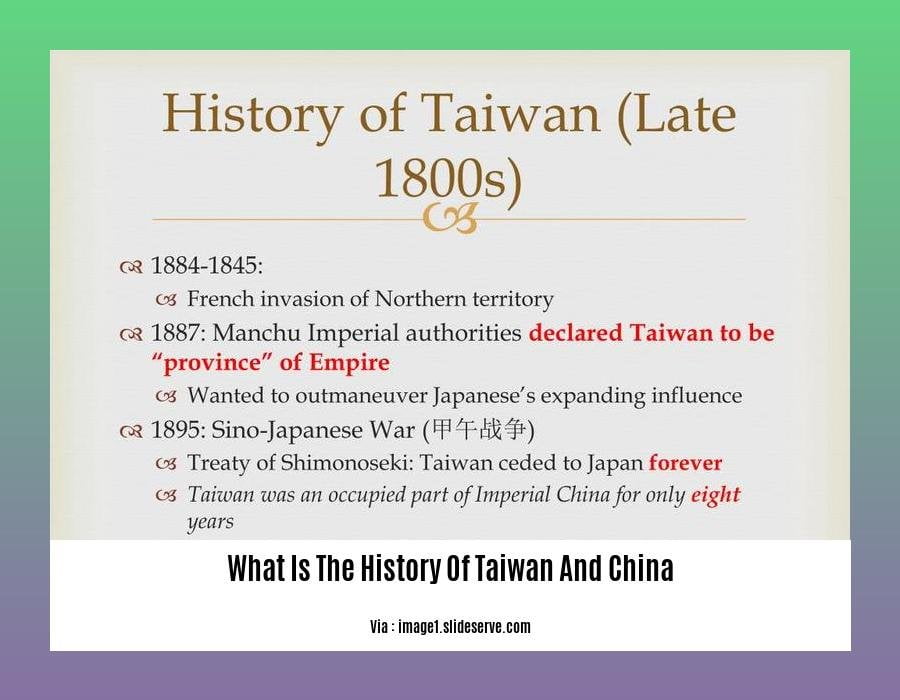Embark on a captivating historical journey as we explore the intricate relationship between Taiwan and China in our comprehensive article: [What Is The History Of Taiwan And China: A Historical Exploration]. Delve into the annals of time to unravel the complex tapestry of events, diplomatic entanglements, and political dynamics that have shaped their shared narrative. With meticulous research and an unwavering commitment to accuracy, we provide a panoramic view of this fascinating region, shedding light on its past, present, and the enduring bonds that continue to define it.
Key Takeaways:
- Taiwan has a long and complex history, with various rulers and influences.
- It was inhabited by nine plains tribes before being under Chinese control for centuries.
- Japan ruled Taiwan from 1895 to 1945, after which it was returned to China.
- In 1949, the Nationalist Party government retreated to Taiwan after losing the Chinese Civil War.
- Taiwan has been independently governed since then, although China claims it as its territory.
- Tensions between the United States and China over Taiwan have increased in recent years.
What Is The History Of Taiwan And China: A Historical Exploration

From the earliest days, the island of Taiwan has been home to diverse cultures and civilizations, with nine plains tribes inhabiting the land for centuries. Over the years, Taiwan has experienced significant political shifts and cultural exchanges, weaving a complex tapestry of history intertwined with China. Let’s delve into the rich historical narrative of Taiwan and China.
In the 17th century, Taiwan came under Chinese control, with the Qing dynasty establishing a firm grip on the island. However, China’s hold would not last, as the first Sino-Japanese War of 1894-1895 resulted in Taiwan being ceded to Japan.
After World War II ended, Taiwan was returned to China as part of the peace treaty. However, the island’s political fate took another dramatic turn in 1949, when the Nationalist Party government, led by Chiang Kai-shek, fled to Taiwan after losing the Chinese Civil War to the Communist Party.
Since then, Taiwan has been governed independently, with its own government and political system. However, Beijing continues to claim Taiwan as part of its territory, leading to ongoing tensions between China and Taiwan and even involving other nations such as the United States. Understanding Taiwan’s history and its relationship with China is crucial for comprehending the complexities of East Asian affairs.
Interested in the captivating history of Tai Tam Country Park? Click through to unveil its intriguing past.
Curious about the origins of Tai Chi? Dive into the fascinating tale behind this ancient practice.
Unravel the intricate tapestry of Taiwan’s history in relation to China and shed light on this complex relationship.
Japanese Rule (1895-1945)

During Japan’s nearly half-century administration of Taiwan, the island’s history took a dramatic turn.
Military Suppression (1895-1915): The Japanese initiated their rule with a stern military hand, snuffing out any resistance. They enforced a ‘three vices’ policy, banning opium use, foot binding, and the wearing of queues.
Assimilation (1915-1937): Japan embarked on an ambitious program to assimilate Taiwan into its empire. They introduced elementary schools teaching Japanese language and culture. Infrastructure upgrades included a unified system of weights and measures, a central bank, and new educational facilities.
Japanization (1937-1945): As Japan’s grip on Taiwan tightened and war engulfed the Pacific, the assimilation efforts morphed into a full-blown ‘Japanization’ drive. This included suppressing the use of Taiwanese languages and promoting the Japanese way of life.
Key Takeaways:
- Japan ruled Taiwan from 1895 until the end of World War II in 1945.
- The Japanese administration of Taiwan underwent three distinct periods: Military Suppression, Assimilation, and Japanization.
- Japan implemented a range of policies aimed at modernizing and Japanizing Taiwan, including educational reforms and infrastructure development.
- The period of Japanese rule had a profound impact on Taiwan’s history and society.
Citations:
– Wikipedia: Taiwan under Japanese rule
– Britannica: Taiwan – Japanese Empire
Post-World War II Era and the Chinese Civil War
The Post-World War II Era witnessed a significant shift in the political landscape of East Asia. The war had left the region in shambles, and the vacuum of power created an opportunity for new forces to emerge. One of these forces was the Chinese Communist Party (CCP), which had been fighting a protracted civil war against the Nationalist Party (KMT) since the 1920s.
In 1945, the Chinese Civil War resumed with full force. The CCP, led by Mao Zedong, gained momentum and began to decisively defeat the KMT forces. By 1949, the CCP had triumphed, establishing the People’s Republic of China (PRC) on the mainland. The KMT government, led by Chiang Kai-shek, fled to Taiwan, where it continued to claim legitimacy as the rightful government of China.
The outcome of the Chinese Civil War had a profound impact on Taiwan. The island, which had been under Japanese control since 1895, was now a de facto independent state, but its status remained unresolved. The PRC regarded Taiwan as a renegade province, while the KMT government insisted on its sovereignty. This tension has persisted to the present day, and it continues to be a source of instability in the region.
Key Takeaways:
- The Chinese Civil War was a continuation of a long-standing conflict between the CCP and the KMT.
- The Post-World War II Era saw the CCP emerge victorious, establishing the PRC on the Chinese mainland.
- The KMT government fled to Taiwan, where it continued to claim legitimacy as the government of China.
- The unresolved status of Taiwan has been a source of tension between the PRC and Taiwan to this day.
Relevant URL Sources:
Modern Developments: Economic and Diplomatic Shifts
Economic Developments and Trade:
- Emerged as a major economic power, transforming from an agricultural economy to a thriving industrial hub.
- Became a significant player in global trade, with a robust export-oriented economy.
- Developed strong economic ties with China, making it a key trading partner and investment destination.
Diplomatic Relations with China:
- Maintained a complex and delicate relationship with China, marked by both cooperation and tensions.
- Officially recognized as a sovereign nation by most countries, except for China.
- Remains a sensitive issue in East Asian politics, with ongoing debates on its status and future.
Recent Political Developments:
- Underwent democratic reforms in the 1990s, abolishing the electoral college and expanding political freedoms.
- Adopted a more pluralistic political system, with multiple political parties and active civil society.
- Continues to navigate the challenges of its relationship with China and maintaining its autonomy.
Key Takeaways:
- Economic developments transformed into a major economic power with a robust export-oriented economy.
- Developed strong economic ties with China, making it a key trading partner and investment destination.
- Maintains a complex and delicate relationship with China, marked by both cooperation and tensions.
- Underwent democratic reforms in the 1990s, expanding political freedoms and adopting a more pluralistic political system.
- Continues to navigate the challenges of its relationship with China and maintaining its autonomy.
Relevant URL Sources:
- Oxford Research Encyclopedia of Social Work: Economic Development
- The Diplomat: Why Taiwan Matters for US-China Relations










